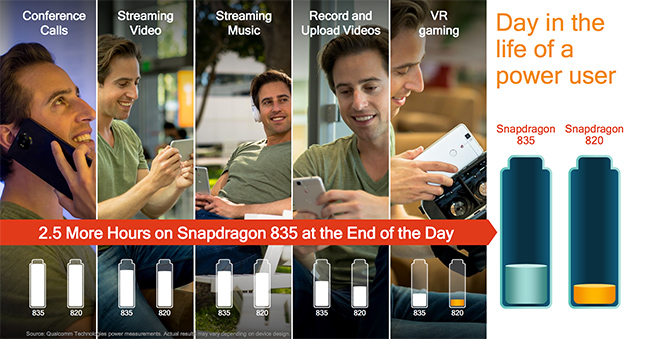The Qualcomm Snapdragon 835 Performance Preview
by Matt Humrick & Ryan Smith on March 22, 2017 4:30 AM EST- Posted in
- Smartphones
- Snapdragon
- Qualcomm
- Mobile
- SoCs
- Snapdragon 835
- Kryo
First Thoughts
Mobile SoCs are packed with specialized processors: CPU, GPU, high-performance DSP (compute), low-power DSP (sensor hub), modem DSP (signal processing), ISP (image processing), fixed-function blocks (video, audio), etc. And while all of these pieces contribute to the overall user experience, some of them are difficult to quantify. The CPU and GPU remain vital to device performance and battery life, so it’s still important to probe their capabilities.
Our initial testing shows that Snapdragon 835’s Kryo 280 CPU is an octa-core, big.LITTLE configuration with four semi-custom A73 “performance” cores and four semi-custom A53 “efficiency” cores. Kryo 280’s performance cores are pretty much equivalent to Kirin 960’s A73 cores in both integer and floating-point IPC, but comparing them to Snapdragon 820’s Kryo CPU shows mixed results: integer IPC improves but floating-point regresses.
In our limited system testing, the Snapdragon 835’s IPC gains outweigh its losses, providing better overall performance than the Snapdragon 820/821 phones. Unsurprisingly, the Snapdragon 835 MDP/S matched the performance of the Mate 9’s Kirin 960, which may not sound all that exciting, but considering our positive experience with the Mate 9, it’s certainly not bad either.
Qualcomm continues to push hard into VR/AR, not just with smartphones but stand-alone HMDs too. The high resolution and low latency requirements for these experiences suddenly make the GPU a bottleneck once again. The Snapdragon 835’s updated Adreno 540 GPU, through a combination of microarchitecture tweaks and a higher peak operating frequency, is another evolutionary step along the VR path, delivering a 25% peak performance boost over Snapdragon 820’s Adreno 530.
As noted earlier, all of these results came from pre-production hardware and software that’s under Qualcomm’s control, so performance could still go up or down once retail units begin shipping; however, based on these preliminary numbers and feature additions, the Snapdragon 835 looks like a solid evolutionary upgrade over the S820. The one glaring omission in this initial assessment, though, is power efficiency, which is critical to both battery life and sustained performance. The potential power savings from the move to 10nm and the CPU swap could have a larger impact on user experience than the small performance gains and new features.













128 Comments
View All Comments
leexgx - Wednesday, April 5, 2017 - link
64bit has not gave them any more speed (even apple said 64bit did not affect speed), more due to cpu and IOS optimisation (just lets them use 4gb later on )melgross - Wednesday, March 22, 2017 - link
They are years ahead.zodiacfml - Wednesday, March 22, 2017 - link
Correct. Apple has the luxury with bigger chips/dies. Their dies are larger than Intel CoreGasaraki88 - Wednesday, March 22, 2017 - link
The A10 is still an ARM processor. They do their own tweaking of the hardware to make it good. They also have full control of the both the hardware and software stack so they can optimize them to work together efficiently.melgross - Wednesday, March 22, 2017 - link
Apple has an architectural license with ARM. They design their chips from the ground up. It's believed that they may have one with Imagination for the GPU as well.The advantage they have is that the OS developers work hand in hand with the hardware designers to optimize both the hardware and OS for each other. No one else can do that.
tuxRoller - Wednesday, March 22, 2017 - link
As others have said, apple's design has been made with very particular goals in mind. Going wider and slower is, normally, more power efficient than narrower and faster, assuming you can actually feed the beast. You pay the cost in silicon and yield, however.ET - Thursday, March 23, 2017 - link
Would be interesting to see Chrome results on all platforms. Using Chrome for Android and Safari for iOS is misleading. As the article said, Qualcomm's internal browser gets 280 in WebXPRT 2015, which trounces the iPhone 7's 208. (Though it's still slower in the other web benchmarks.)Achtung_BG - Wednesday, March 22, 2017 - link
die size maybe less the 80mm2?prime2515103 - Wednesday, March 22, 2017 - link
Just a suggestion...Since this is a preview of a chip, and not an actual phone review, I think it would be helpful if the model of the chip in each phone be put next to them in the charts instead of just the S7. It's quite inconvenient to have to go look it up while in the middle of reading the article.
With that said, I've noticed that mobile chips tend to vary a more widely from generation to generation than desktop parts seem too (they loose ground in certain areas, with big drops in the 20%+ range).
Is this a result of a compromise for power reduction, or are they just not as good at this yet as Intel?
StevoLincolnite - Wednesday, March 22, 2017 - link
+1Would be also great if we could include other SoC's like Tegra.